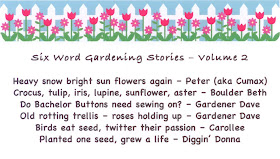
A worker at Denver Botanic Gardens first pointed a Fern-leaf Peony out to me. (“You want to see a cool plant?” “Sure.”) When I noticed it offered in a southeastern U.S. nursery catalog, I had to have one. That was about 15 years ago. I don’t remember the price, but recall it was “pricey!” Like all peonies, it was slow to establish, maybe slower than its larger, elegant cousins. The photo shows this year’s performance in early May.
The Fern-leaf isn’t as tall as standard peonies. It blooms earlier. Its flowers are smaller (and don’t flop over). It comes only in red. My plant is double, and as with other peonies, as the flowers age, they open wider to reveal orange-yellow stamens. I understand there is also a single-flowered version, but I have not seen it. Late spring frosts don’t seem to bother the foliage, but will damage the flowers. As summer progresses, the ferny foliage withers, but faithfully reappears in the spring. I’ve never noticed ants on my plant.
The Fern-leaf allegedly was carried to the West by early settlers. I’ve heard that story from a local nurseryman. I also found it posted on the Internet by a grower in Indiana. I’ve pondered why this plant might have been selected for the long trek west, and why it is one of those few plants to have earned mention in pioneer lore. Perhaps it has been seen as a tough, persistent survivor that embodies the spirit of Western settlement.
.jpg)


















































